TO
Filters: Research Institute: "Institute for Clean and Secure Energy (ICSE)" Collection: "ir_eua" Format: "application/pdf"
| Title | Date | Subject | Description | ||
|---|---|---|---|---|---|
| 201 |
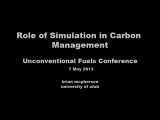 |
Role of simulation in carbon management | 2013-05-07 | ICSE; Unconventional fuels; Carbon; CCS; Simulation | Presentation given at the University of Utah Unconventional Fuels Conference, Salt Lake City, Utah, May 7, 2013. |
| 202 |
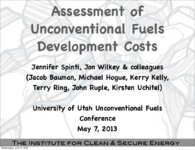 |
Assessment of unconventional fuels development costs | 2013-05-07 | ICSE; Unconventional fuels; Development cost; Oil Shale; In situ; Ex situ; Oil Sands; Utah; Uinta Basin | Presentation given at the University of Utah Unconventional Fuels Conference, Salt Lake City, Utah, May 7, 2013. |
| 203 |
 |
Utah BLM lands - our energy portfolio: The president's commitment to a sustained, all-of-the-above energy strategy | 2013-05-07 | ICSE; Unconventional fuels; Federal lands; Energy development | Presentation given at the University of Utah Unconventional Fuels Conference, Salt Lake City, Utah, May 7, 2013. |
| 204 |
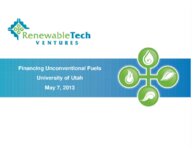 |
Financing unconventional fuels | 2013-05-07 | ICSE; Unconventional fuels; Energy deveopment; Energy financing | Presentation given at the University of Utah Unconventional Fuels Conference, Salt Lake City, Utah, May 7, 2013. Unconventional fuels project. |
| 205 |
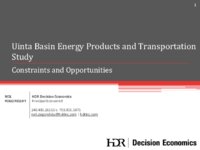 |
Uinta Basin energy products and transportation study: Constraints and opportunities | 2013-05-07 | ICSE; Unconventional fuels; Transportation; Uinta Basin | Presentation given at the University of Utah Unconventional Fuels Conference, Salt Lake City, Utah, May 7, 2013. |
| 206 |
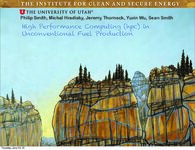 |
High performance computing (hpc) in unconventional fuel production | 2013-05-07 | ICSE; Unconventional fuels; High performance computing; unconventional fuel production | Presentation given at the University of Utah Unconventional Fuels Conference, Salt Lake City, Utah, May 7, 2013. |
| 207 |
 |
Unconventional fuels conference: Welcome | 2013-05-07 | ICSE; Unconventional fuels | Presentation given at the University of Utah Unconventional Fuels Conference, Salt Lake City, Utah, May 7, 2013. |
| 208 |
 |
Mineral management plan: Glen Canyon National Recreation Area--Arizona and Utah | 1980-03 | A General Management Plan (GMP) for Glen Canyon National Recreation Area was prepared during the period 1973 - 1979 and was approved on November 21, 1979, after it and an accompanying final environmental statement (FES 79-23) had been released to the public. That Plan called for the preparation of a... | |
| 209 |
 |
Mineralogy of Sunnyside, Utah tar sand deposits | 1981-04-09 | X-ray diffraction; Mineralogy; Sunnyside, Utah; Tar sand deposits | Mineralogy as determined by x-ray diffraction is reported in the attached tables. |
| 210 |
 |
Microstructural distribution of sulfur during the retorting and oxidation of oil shale | 1982-11 | Oil shale; Retorting; Combustion; Sulfur; Microstructural distribution | We report here the first direct observations of the mineralogical and chemical changes in oil shale caused by retorting and combustion. Electron microprobe and scanning electron microscopy techniques were used to examine a portion of the surface area of a sample in the raw shale state, the same area... |
| 211 |
 |
Mathematical modeling of modified in situ and aboveground oil shale retorting | 1981-01 | mathematical modeling; modified in situ; aboveground oil shale retorting; oil shale | A one-dimensional mathematical model has been developed for simulating the chemicophysical processes involved in the vertical retorting of a rubblized bed of oil shale. Included in the present model are those processes believed to have the most important effects in either the hot-gas retorting mode ... |
| 212 |
 |
Hot water processing of U.S. tar sands -- Water recycle and tailings disposal | 1984 | hot water processing; U.S. tar sands; water recycle; tailings disposal; bitumen recovery | Tailings disposal and water recycle are vital factors for the industrial development of a hot water process for the recovery of bitumen from U.S. tar sands. Based on batch laboratory experiments, with 4 to 12 kg tar sand charge, tailings sedimentation behaviours are presented and discussed for tar s... |
| 213 |
 |
General model of oil shale pyrolysis | 1983-11 | oil shale; oil shale pyrolysis; oil shale pyrolysis model; general kinetic model; kerogen pyrolysis; liquid oil vaporization; liquid oil | Our general chemical kinetic model for oil shale pyrolysis has been further developed. The reactions included in the model are primary pyrolysis of kerogen, vaporization of liquid oil, coking of liquid oil, hydrogenation of liquid oil, cracking of liquid oil, cracking of oil vapor, secondary and ter... |
| 214 |
 |
Median residence and dispersion times for fluidization of crushed oil shale | 1983-03-24 | median residence and dispersion; fluidization of crushed oil shale; crushed oil shale | Median residence times and dispersions for crushed oil shale flowing downward through a fluidized bed were measured as a function of particle size, nominal residence time, and fluidizing gas velocity. For fluidized beds containing narrow particle-size distribution, it was found that median residence... |
| 215 |
 |
Mechanism of low-temperature water evolution from Green River Formation oil shale | 1989-04 | low-temperature water evolution; Green River Formation; oil shale; Mahogany Zone | The water evolved from Green River Formation oil shale (Mahogany Zone) at temperatures between 150 and 400°C as heated at the rate of 4°C/min results from analcime dehydration, and its rate of evolution is affected by the kinetics of dehydration, the transport of water inside and outside oil shale... |
| 216 |
 |
Lawrence Livermore National Laboratory oil shale | 1983-08-09 | oil shale; oil shale project; pyrolysis; quarterly report. | Our general chemical kinetic model for oil shale pyrolysis has been further developed. The reactions included in tne model are primary pyrolysis of kerogen, vaporization of liquid oil, coking of liquid oil, hydrogenation of liquid oil, cracking of liquid oil, cracking of oil vapor, secondary and ter... |
| 217 |
 |
Informational core drilling in Utah's oil-impregnated sandstone deposits, southeast Uinta Basin Uinta Couny, Utah | 1974-02 | core drilling; Utah's oil-impregnated sandstone deposits; coring; Rim Rock; P. R. Spring; Hill Creek | This program was undertaken under Grant No. GO122094 from the U.S. Department of the Interior, Bureau of Mines to the Utah Geological and Mineral Survey, dated June 15, 1972. Amount of the grant was $77, 200. Principal investigator was Howard R. Ritzma, Petroleum Geologist, Utah Geological and Miner... |
| 218 |
 |
Kerogen oil value enhancement research | 2002-05-22 | Kerogen; Kerogen oil; oil value enhancement; pure compounds; broad range concentrates; sweet refinery feedstock. | Three general categories of products from the Estonia Kukersite kerogen oil were defined: pure compounds, broad range concentrates, and sweet refinery feedstock. Product development and market research center on these three categories. Further attempts were made to identify and test chemical approac... |
| 219 |
 |
In situ recovery of oil from Utah tar sand: A summary of tar sand research at the Laramie Energy Technology Center | 1985-10 | in situ recovery; oil recovery; Utah tar sand; tar sand research; Laramie Energy Technology Center; LETC; future recovery of oil; U.S. tar sands | Executive Summary: This report describes work done by the United States Department of Energy's Laramie Energy Technology Center (LETC) from 1971 through 1982 to develop technology for future recovery of oil from U.S. tar sands. Work was concentrated on major U.S. tar sand deposits that are found in ... |
| 220 |
 |
Interpretation of fischer assay data for the evaluation of analcime-bearing oil shale in the Green River Formation, Colorado and Utah | 1975 | fischer assay data; analcime-bearing oil shale; Green River Formation; potential oil yeild of sediments | Using Fischer assay data, an empirical method has been devised for distinguishing analcime-rich oil shale from oil shale which is essentially free of analcime in the Parachute Creek Member, Green River Formation, Colorado and Utah. This method permits evaluation of Fischer assay data in order to com... |
| 221 |
 |
KTIA corporate introduction | 2009-02-27 | KTIA; KTI; mines | Overview of KTIA's continuing oil sands development activities in Utah, presented at the 2009 Western U.S. Oil Sands Conference by Soung-Joon Kim, Chief Operating Officer, Korea Technology Industry America, Inc. |
| 222 |
 |
In situ RF heating for oil sand and heavy-oil deposits | 1985-05 | in situ RF heating; oil sand; heavy-oil deposits; IITRI; energy efficiency; in situ radio-frequency heating process; oil shale; tar sand | Since the mid 1970s, IIT Research Institute (IITRI) has been developing an energy efficient, in situ radio-frequency (RF) heating process. Large blocks of oil shale or tar sand typically found in the Western United States have been emplanted with closely spaced electrodes and excited electromagnetic... |
| 223 |
 |
Inventory of Sunnyside Tar Sands data: Located at the Utah Geological Survey | 2004-05-18 | Sunnyside Tar Sands data; Utah geological survey | |
| 224 |
 |
Kinetics of Colorado oil shale pyrolysis in a fluidized-bed reactor | 1985-05 | kinetics of Colorado oil shale pyrolysis; fluidized-bed reactor; oil shale pyrolysis; oil shale; hydrocarbon evolution | The hydrocarbon evolution data of Richardson et al. (1982) is reanalyzed to determine improved rate expressions for oil generation from Colorado oil shale under rapid pyrolysis conditions. Contributions from low molecular weight gases are subtracted from flame ionization detector data to obtain the ... |
| 225 |
 |
Geologic summary report of the 1984 exploration program, Sunnyside Tar Sands project, Carbon County, Utah--volume 1 | 1985-06 | geologic summary; exploration program; tar sands; Sunnyside tar sand deposit. | The 1984 Sunnyside exploration program consisted of: (1) diamond drilling of fifteen drill holes, (2) logging of all core and (3) additional geological mapping in the north area to better define the limits of the tar sands associated with the Sunnyside delta complex. Both regional and detailed geolo... |
